6-Sigma bisic
6sigma basic

2. 评估选择对策
Ease to Possible Counteraction Effectiveness Implement Cost Safety Impact on Other Ys
六西格玛产生的背景
六西格玛产生的背景
BBP Workshop JIT Seating Saarlouis/Bochum
90年代早期,摩托罗拉在同日本的竞争中 年代早期, 年代早期 失掉了收音机和电视机的市场, 失掉了收音机和电视机的市场,后来又失掉 机和半导体的市场。 了BP机和半导体的市场。一个日本企业在 机和半导体的市场 一个日本企业在70 年代并购了摩托罗拉的电视机生产公司。 年代并购了摩托罗拉的电视机生产公司。经 过日本人的改造后,很快投入了生产, 过日本人的改造后,很快投入了生产,并且 不良率只有摩托罗拉管理时的1/20。 不良率只有摩托罗拉管理时的 。 他们使用了同样的人员、技术和设计。 他们使用了同样的人员、技术和设计。显 然问题出在摩托罗拉的管理上。 然问题出在摩托罗拉的管理上。在市场竞争 中,严酷的生存现实使摩托罗拉的高层接受 了这样的结论“我们的质量很差” 了这样的结论“我们的质量很差”。
认识机会
什么过程对业 务影响最大 什么表现与客 户要求差距最 大
1. 业务收益
公司战略目标
2. 客户满意
Annual Goal
3. 可持续发展
Annual Goal
Annual Goal
$
六西格玛突破的策略:
确定项目
BBP Workshop JIT Seating Saarlouis/Bochum
六西格玛基本知识详解
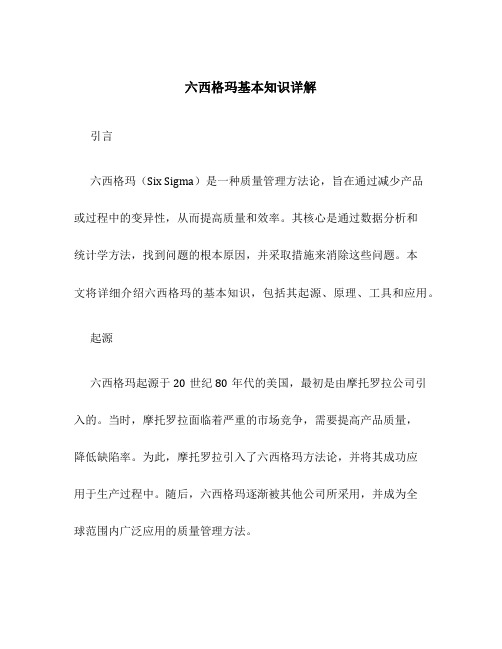
六西格玛基本知识详解引言六西格玛(Six Sigma)是一种质量管理方法论,旨在通过减少产品或过程中的变异性,从而提高质量和效率。
其核心是通过数据分析和统计学方法,找到问题的根本原因,并采取措施来消除这些问题。
本文将详细介绍六西格玛的基本知识,包括其起源、原理、工具和应用。
起源六西格玛起源于20世纪80年代的美国,最初是由摩托罗拉公司引入的。
当时,摩托罗拉面临着严重的市场竞争,需要提高产品质量,降低缺陷率。
为此,摩托罗拉引入了六西格玛方法论,并将其成功应用于生产过程中。
随后,六西格玛逐渐被其他公司所采用,并成为全球范围内广泛应用的质量管理方法。
原理六西格玛方法论的核心原理是通过数据分析和统计学方法,找到问题的根本原因。
它基于以下两个基本假设:1.大部分质量问题是由于过程的不稳定性和变异性引起的。
2.通过减少过程的变异性,可以提高质量和效率。
为了实现这一目标,六西格玛采用了一套严格的方法和工具,包括项目选择、团队组建、问题定义、数据收集、数据分析、改进措施的实施和控制。
工具六西格玛方法论涵盖了许多工具和技术,用于数据分析和问题解决。
以下是其中一些常用的工具:1.流程图:用于可视化和分析业务流程,找出潜在问题和改进点。
2.直方图:用于展示数据的分布情况,帮助识别过程中的偏差和异常。
3.散点图:用于分析两个变量之间的关系,发现潜在的因果关系。
4.控制图:用于监控过程的稳定性和一致性,及时发现和纠正问题。
5.核对表:用于收集和整理数据,辅助问题定义和根本原因分析。
6.样本调查:用于获取关于客户满意度和需求的信息,作为改进措施的依据。
除了以上列举的工具,六西格玛方法论还包括统计学方法如回归分析、方差分析等,以及质量管理工具如5W1H分析、鱼骨图等。
应用六西格玛方法论在各行各业都得到了广泛的应用。
它可以适用于产品制造、服务业、医疗保健、金融等各个领域。
以下是一些典型的应用场景:•减少生产过程中的缺陷率:通过分析生产过程中的数据,找到引起缺陷的根本原因,并采取相应的改进措施,从而降低产品缺陷率。
六个西格玛介绍

ZLT = 4.5 ZST = 6.0
• 统计工具应用于 定义 – 定义源于客户问题的商业问题。 测量 – 测量现有工序。 分析 – 确定工序的关键因素。 改进 – 优化关键因素。 控制 – 控制关键因素。
何谓六个西格玛
• 它是一种思维方式,一种决策方法。 • 在需要时所运用的工具或技巧。
• 分析:
分析在测量阶段所收集的数据,以确定一组按 重要程度排列的影响质量的变量。
• 改进:
优化解决方案,并确认该方案能够满足或超过 项目质量改进目标。
• 控制:
确保对工序的改进一经实施就能够持之以恒, 并确保工序不会返回到以前的状态。
• 定义 • 衡量
• 分析
DMAIC
1. 确定项目的CTQ 2. 管理层审批 3. 高级过程图
W3.9
DMAIC过程
定义
测量
控制
改进
分析
DMAIC是: • GE 以数据为基础的质量
方法,用于改进现有的产 品和工序。
当现有的产品或工序经改进能够满足或超越客户的要求,而同时 还能够支持GE商业目标的时候,应该使用DMAIC过程。
运用DMAIC方法减少缺陷将带来
• 更高的客户满意度 • 质量成本 的下降
• 以世界上最好的公司作为参 照基准进行比较
• 认为99%是无法接受的
• 从外部出发定义质量关键点 (CTQ)
六个西格玛衡量指标- Z
ZST ZLT
PPM
缺陷减少5倍 缺陷减少11倍
缺陷减少26倍 缺陷减少68倍
工序能力 - Z
每百万机遇的 缺陷
西格玛值是一种反映工序能力的统计度量单位。西格玛值与单 位产品缺陷、百万机会之缺陷和故障/错误发生的概率等指标密 切相关。
Six sigma basics(6 斯伽马)
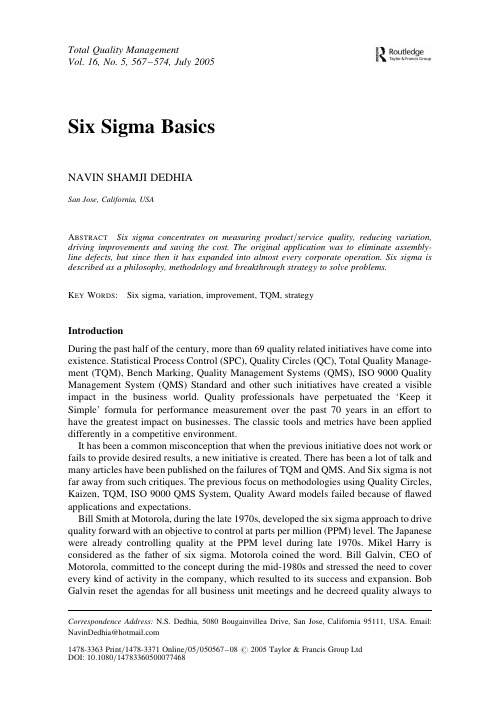
Six Sigma BasicsNAVIN SHAMJI DEDHIASan Jose,California,USAA BSTRACT Six sigma concentrates on measuring product /service quality,reducing variation,driving improvements and saving the cost.The original application was to eliminate assembly-line defects,but since then it has expanded into almost every corporate operation.Six sigma is described as a philosophy,methodology and breakthrough strategy to solve problems.K EY W ORDS :Six sigma,variation,improvement,TQM,strategyIntroductionDuring the past half of the century,more than 69quality related initiatives have come into existence.Statistical Process Control (SPC),Quality Circles (QC),Total Quality Manage-ment (TQM),Bench Marking,Quality Management Systems (QMS),ISO 9000Quality Management System (QMS)Standard and other such initiatives have created a visible impact in the business world.Quality professionals have perpetuated the ‘Keep it Simple’formula for performance measurement over the past 70years in an effort to have the greatest impact on businesses.The classic tools and metrics have been applied differently in a competitive environment.It has been a common misconception that when the previous initiative does not work or fails to provide desired results,a new initiative is created.There has been a lot of talk and many articles have been published on the failures of TQM and QMS.And Six sigma is not far away from such critiques.The previous focus on methodologies using Quality Circles,Kaizen,TQM,ISO 9000QMS System,Quality Award models failed because of flawed applications and expectations.Bill Smith at Motorola,during the late 1970s,developed the six sigma approach to drive quality forward with an objective to control at parts per million (PPM)level.The Japanese were already controlling quality at the PPM level during late 1970s.Mikel Harry is considered as the father of six sigma.Motorola coined the word.Bill Galvin,CEO of Motorola,committed to the concept during the mid-1980s and stressed the need to cover every kind of activity in the company,which resulted to its success and expansion.Bob Galvin reset the agendas for all business unit meetings and he decreed quality always to Total Quality ManagementVol.16,No.5,567–574,July2005Correspondence Address:N.S.Dedhia,5080Bougainvillea Drive,San Jose,California 95111,USA.Email:NavinDedhia@1478-3363Print =1478-3371Online =05=050567–08#2005Taylor &Francis Group Ltd DOI:10.1080=14783360500077468568N.S.Dedhiabefirst.Galvin’s message was,if quality objectives were met,everything else would follow satisfactorily.Galvin would not permit the quality manager to present the quality report. That report had to be provided by the top business unit manager.As a result,the business manager had to understand the qualityfigures to be able to defend the report if it was challenged.Allied Signal was one of thefirst to apply six sigma in its operation.Bob Galvin of Motorola and Jack Welch of General Electric(GE)are good examples of executives,who took a leadership approach in the six sigma methodologies and appli-cations.Six sigma at GE became a company policy in October1995.Six Sigma quality level equates to a3.4Parts Per Million(PPM)defect rate or3.4 defects occurring per million opportunities(DPMO).Six Sigma quality level is like parking a small car in a relatively large space.Quality ToolsDifferent quality tools have a different emphasis.Total Quality Management,Malcolm Baldrige National Quality Award(MBNQA)Criteria for Performance Excellence,ISO 9000Standard and Six Sigma all aim at reducing cost and enhancing customer satisfac-tion.In principle,all these tools can be defined succinctly:Total Quality Management(TQM)The TQM approach creates an awareness in the organization.It is a cost effective system for integrating the continuous improvement efforts of people at all levels in an organi-zation to deliver products,services and solutions,which ensure customer satisfaction. Baldrige Criteria for Performance ExcellenceThe Baldrige Criteria for Performance Excellence focuses on performance excellence for the entire organization in an overall management framework.It identifies and tracks all important organizational results and effectiveness.It helps to determine‘Where the organ-ization is’.Essentially,performance excellence criteria involve the regular and systematic review of an organization’s activities and results.The process allows an organization to clearly discern its strengths and areas for improvement.Baldrige criteria are a holistic integrated set of criteria that addresses best business practices.ISO9000QMS StandardThe ISO9000QMS Standard installs a system in the organization using a process approach.It concentrates onfixing quality system defects and product/service non-conformities.It also helps to document‘What the organization is doing’.It is an organized approach to managing elements of a business in such a way that it fosters continual improvement and customer satisfaction.ISO9000requires fundamental concepts and a framework of process approach to be effective.Six SigmaSix sigma concentrates on measuring product/service quality,reducing variation and driving process improvements and reducing cost.It uses a set of statistical and management tools that can make leaps in improvement.The Six sigma process has a failure rate of3.4Six Sigma Basics569 parts per million(PPM)or99.99966%defect-free product.It uses a complicated approach to problem solving called DMAIC(Define,Measure,Analyse,Improve and Control).Six sigma is the foundation for driving breakthrough improvements.Six Sigma MethodologiesPoor quality costs amount to20to30%of a company’s revenues.Six sigma improvement activities should be carried out in a project form.The prioritization and selection of projects to be worked is vital to the success.A well thought-out introduction plan should be developed.Six sigma should occur in the early life cycle(research and design stage) of a product.Strategic process improvements are needed to compete in the market place. Six sigma in organizations is built around the customer’s needs.A six sigma project recognizes a performance gap,and goes through DMAIC steps before attempting a solution.It is more about reducing variation.Six Sigma is primarily a methodology for improving the capability of business pro-cesses by using statistical methods to identify and decrease or eliminate process variation. Its goal is defect reduction,elimination and improvement.A structured project approach and effective execution of the project are the keys to the success of the Six Sigma process.Characteristics of Six Sigma include:.Expected bottom line results delivered..Senior management leadership..A disciplinedfive step approach using Define,Measure,Analyse,Improve and Control (DMAIC)concept..Rapid project completion..Clearly defined performance measurements..A sound statistical approach to focusing on critical areas of a process for improvement. Six sigma is an evolution of the TQM approach.Six Sigma has integrated other tools and methodologies such as Cause-and-Effect Diagram,Poka-Yoke device(mistake-proof mechanism to prevent obvious errors),Kaizen(continuous improvement),Kanban (pulling of a product instead of pushing through a production process),Lean Manufactur-ing(reducing and preventing wastes),ISO9000(process system approach)and House of Quality(Quality Function Deployment or Voice of the Customer).Fundamentally,.Six Sigma relies on total commitment from leadership team..Projects and initiatives are aligned with strategic objectives of the organizationSix Sigma emphasizes checking,inspection,audit and analysis..Empowered employees tackle issues proactively rather than reactively..Six Sigma is a problem solving methodology using systematic and organized project management tools.Initially,Motorola set a10times improvement during thefirst year,100times improvement during the third year and achieving six sigma during the fourth year.It meant reducing defects by10Âduring thefirst year of launching the program.Then within the next two years reducing defects by100Âto achieve six sigma level during the fourth year.Success requires committing to bold actions,continuous improvement and individual accountability.570N.S.DedhiaDMAIC steps involve:(1)Define:The problem has to be defined clearly and explicitly.It is a major step inselecting and prioritizing a project.A well-defined problem clearly sets ground rules for improvement.(2)Measure:Measurement points,sources,tools and equipment,and precision and accu-racy play a vital role in the project.Without measurement there is no control.Measurements are essential to collect data.(3)Analyse:The right approach in using analytical tools or methods will help tofind aclearly defined solution.Data are analysed into information to create a knowledge base and make decisions for actions.(4)Improve:Selecting the best alternative solution and implementing to remove the causeof a problem will bring the desired result.Improvements can be in the form of efficient equipment,new process,enhanced training to the employees,or new material.Impro-vements are actions,both corrective and preventive.(5)Control:After the implementation of improvement activities,monitoring becomesessential to control the processes.Six Sigma AppreciationCritics have already started labelling six sigma with such phrases as‘sick sigma,program of the month or an old wine in the new bottle’.Allfive senses are required to appreciate the wine.Thesefive senses are see,smell,touch,hear and taste.Six sigma application can only be appreciated when all thefive senses are applied.Thesefive senses play a key vital role in selling the six sigma programme to the management.(1)Seeing or observing with eyesEyes do the function of seeing and observing and thus providing evidence to support the claim.A criminal is innocent until proven guilty with evidence from witnesses.ISO9000standard requires supporting evidence for the observed non-conformity.Six sigma application is appreciated when noticing the benefits received from the six sigma project.These benefits come in the form of a cycle time reduction,cost reduction,savings in resources,yield increase,defect reduction,increase in the profits,space savings,etc.(2)Smelling with the noseA pleasant smell is always enjoyable and creates a thought-provoking environment.An event becomes memorable with a fragrance of a rose or an essence or an aroma of a wine.An organization’s environment remains happy and cheerful from the success of six sigma project and the resulting cost savings.(3)Touching with handsTouching gives a sense about the usefulness of an object and characterizes the surface as rough,smooth,hard or soft.Statistical,analytical and management tools are used to tackle a clearly defined problem.(4)Hearing with earsPeople like to hear sweet words and a sweet voice.Hearing excellent results from the six sigma project is as sweet as a song.Six Sigma Basics571 (5)Tasting with the tongueFood can only be tested when put in the mouth.When an application of six sigma tools and techniques bear the desired results,its value is known.Six Sigma SuccessSix sigma is not like a laser-guided smart bomb,but,rather,a statistically heavy regimen of analysing problems that has saved corporations billions of dollars.Numerous large and well-known corporations such as Motorola,General Electric,American Express,Ford Motor Company,and Allied Signal all have ambitiously applied the six sigma method-ologies in their operations.Impressive results have been obtained by the companies apply-ing a six sigma project in their organizations,as evidenced by:(1)Motorola Legal Department took two years for the patent application.Bob Galvinwanted the patent department tofigure out how to make the application time less ing six sigma tools,the patent department reduced time to somewhat less than that and the shortest time was17days.Motorola generated savings of$1.5 billion in a11year period.(2)A Japanese patent system’s application process cost was reduced from$48,000to$1200for eachfiling.(3)General Electric(GE)increased communication satellites’usage from63%to97%realizing a revenue increase of$1.3million/year.GE changed the original Motorola Six Sigma model to a project based approach that had executive buy-in.GE saved$2 billion during1999.(4)The Ames Rubber Corporation(1993recipient of the Malcolm Baldrige NationalQuality Award in Small Business Category)uses the Baldrige criteria,ISO9000Quality Management System and six sigma tools for continuous improvement activities. (5)The National Science Foundation achieved a reduction of sick people evacuationfrom Antarctica to22%with help from Raytheon Corporation on ways to pre-screening scientists prior to engaging them.(6)A hospital in Milwaukee,Wisconsin,used six sigma process to reduce prescriptionerrors.(7)Samsung Electronics Co.(SEC)of Seoul,Korea,uses six sigma tool for innovation,Efficiency and quality.SEC completed3,290six sigma projects during2000and2001.(8)Using six sigma techniques,American Express improved their plastic issuanceprocesses.(9)DuPont used six sigma methodologies to improve the cycle time to process appli-cations for long-term disability benefits.(10)Fort Wayne,Indiana,local governmentfilled98%of the potholes within24hoursusing six sigma project.(11)Military contractors were early implementers of six sigma(Ex:Northrop Grumman,etc.)(12)US Federal Government authorities are looking into six sigma application tofight the‘war on terrorism’(Homeland Security Project).Companies save an average of$100,000to$200,000per implemented improvement panies that have produced good results,have invested adequate resources, provided extensive training and involved many individuals.572N.S.DedhiaSix sigma success requires:.Strong proactive support with required resources provided by the top management. .Acceptance and implementation of six sigma’s basic disciplines by employees.The role of middle management has to be active and supportive for the success of a six sigma. Managers at all levels are required to be active..Linkage with all innovative and infrastructure activities..Accurate and fair evaluation of all successful six sigma projects with meaningful recognition and rewards for employees.General Electric made it clear that there will be no promotions without active participation in six sigma activities.Volvo refers to its Black Belts at future leaders.Lean Six SigmaThe lean manufacturing technique was developed by Toyota Motor Corporation in Japan. Lean tools are used to reduce waste and improve the efficiency of a process.Six sigma tools are used when the goal is to reduce variance and improve the performance. Keeping in mind the constraints,the lean manufacturing technique focuses on eliminating barriers to achieve a smooth continuous processflow.In six sigma,the focus is on elim-inating variation to reduce cost and cycle time and improve quality.Subject experts are trained differently and subjects are deployed differently in lean manufacturing and six sigma.Their approachesfit different types of problems.Lean and six sigma have a positivefinancial impact.Both need management’s active support and both can also be used in the non-manufacturing environment.Savings can be doubled,when lean and six sigma are used in a coordinated manner.Total Productive Maintenance(TPM)is used in the lean manufacturing technique to ensure equipment is operational and available when required.Single Minute Exchange of Dies(SMED)from the lean technique and Design of Experiment(DOE)from six sigma are used to achieve optimal results.The lean technique is aimed at creatingflow through the entire value stream.Six sigma works on reducing variation among the processes that operate on a product.Lean helps uncover the rocks in the value stream that can cause blockages or unnecessary variation in theflow.Six sigma helps tofind the rocks in the value stream.Lean goes beyond Just-In-Time(JIT)and TQM.Six sigma goes beyond TQM.Lean and six sigma both focus on increasing productivity,asset utilization and quality.Six Sigma BenefitsA number of benefits are realized when the six sigma process is applied in a systematic way.A hugefinancial payoff is realized within a short period of time.Some of these benefits are:.Decreased work-in-progressBottlenecks are removed and workflows smoothly in the line,thereby reducing in process inventory.Equipment and tools are utilized efficiently with decreased work-in-progress.There is no wait in line.Six Sigma Basics573 .Improved capacity and outputDue to decreased work-in-process,more can be produced and shipped..Improved customer satisfaction and processflowOn-time shipping and on-time delivery of goods will make customers happy..Improved inventory turnsWith decreased work-in-progress and improved output,product will move faster out the door.There will be less inventory of raw material andfinished product..Increased productivityProductivity increase is realized when equipment and tools are running at capacity and wastage is reduced..Reduced cycle timeFrom start tofinish,the job can be done within the prescribed time.Waiting is removed from the operation.Six Sigma EnvironmentThe success of a Six Sigma project depends on the role played by the team members,who are:(a)Executive(Involve in committing resources and sponsoring the project)(b)Master Black Belt(Training and coaching)(c)Black Belt(Lead improvement projects)(d)Green Belt(Support and run projects)(e)Champion(Involve in supporting the project)Master Black Belts(MBBs)provide training and support for both Black and Green Belts. Black Belts(BB)and Green Belt(GB)holders conduct the improvement projects.Master Black Belt and Black Belt holders are full-time improvement specialists having obtained four weeks’training over a four-month period.Green Belt holders are part-time improve-ment specialist and retain their previous job duties.They receive two weeks’training over a two-month period.Executive leaders establish the strategic focus of a Six Sigma programme.Champions take their company’s vision,missions,goals,and metrics and translate them for individual projects.The Executives and champions keep the programme moving in a planned direction.Executives attend a one-day Executive training session. Champions receive one week of training.Mikel Harry,one of Six Sigma’s creators and chief promoters,introduced the belt system for designating experience levels.Master Black Belts and Black Belts form the backbone of the Six Sigma program.Questions still arise at the validity of six sigma application infixing rare and random problems.Fewer than15%of the Fortune1000companies have embraced it in a significant way.Michael Dell,CEO of Dell Computers,says it is powerful stuff.Jack Welch,CEO of GE,says it requires obsessive and compulsive commitment to drive six sigma deep into a company’s culture.Success of six sigma demands on management com-mitment,full support,a trained workforce and cross-functional teams.The American Society for Quality(ASQ)offers the Six Sigma Black Belt(SSBB) Certification Examination twice a year.It is a150multiple-choice-question four-hour574N.S.Dedhiaexamination.The ASQ certification examination application requires two completed six sigma projects documented by signed affidavits or one project with a signed affidavit and three years of work experience related to six sigma activities.ASQ certification is not a licence or registration.It is peer recognition.ASQ launched a quarterly Six Sigma Forum Magazine in June2002.An annual six sigma conference is held by ASQ.ASQ started the Six Sigma Forum in May2001with an aim of connecting six sigma knowledge with experience for quality professionals.The ASQ Six Sigma Black Belt examination requires knowledge and understanding of:(1)Enterprise wide deployment(2)Business process management(3)Project management(4)Defining,measuring,analysing,improving and controlling six sigma improvementmethodology and tools(5)Lean enterprise(6)Design for six sigmaConclusionSix sigma,as developed by Motorola,was an extension of many existing quality tools and techniques,but with the addition of business accountability.This resulted in process improvement gains that increased productivity and profitability.Six sigma and Lean enter-prise methodologies are both systematic and both have evolved from separate paths.Lean was developed by Toyota.Lean is mainly focused on eliminating waste.In manufacturing, the lean principle includes zero waiting time,pull instead of push scheduling,smaller batch sizes,line balancing and shorter process times.Six Sigma organizations become forward moving organizations by adapting new tools and techniques and overcoming learning disabilities.Much can be achieved from programmes like six sigma with the active,consistent, innovative,continuous and widely apparent participation by top management.When implemented strategically,six sigma can help companies turn over working capital faster,reduce capital spending,make existing capacity available,produce better results from the design and R&D functions.Such outcomes also foster a working environ-ment that stimulates employee development,motivation,morale empowerment and commitment.The primary factor in the successful implementation of a six sigma project is to have the necessary resources,the support and leadership of top management,customer require-ments identified explicitly,and a comprehensive training programme.Six sigma’s DMAIC structure of problem solving is its ability to analyse,improve and control processes with an emphasis on the ability to measure the performance.Deploy-ment of six sigma is best achieved through the defined projects.Success of a six sigma project depends on buy-in by the entire organization,deployment of the process,effective training and key measurements.。
六西格玛six-sigma

简介六西格玛(Six Sigma),又称:六式码、六标准差、6σ、6Sigma,不能使用大写的Σ,西格玛(Σ,σ)是希腊文的字母,在统计学中称为标准差,用来表示数据的分散程度。
其含义引申后是指:一般企业的瑕疵率大约是3到4个西格玛,以4西格玛而言,相当于每一百万个机会里,有6210次误差。
如果企业不断追求品质改进,达到6西格玛的程度,绩效就几近于完美地达成顾客要求,在一百万个机会里,只找得出3.4个瑕疵。
六西格玛(6σ)概念作为品质管理概念,最早是由摩托罗拉公司的麦克.哈里于1987年提出,其目的是设计一个目标:在生产过程中降低产品及流程的缺陷次数,防止产品变异,提升品质。
真正流行并发展起来,是在通用电气公司的实践,在杰克韦尔奇于20世纪90年代发展起来的6σ(西格玛)管理是在总结了全面质量管理的成功经验,提炼了其中流程管理技巧的精华和最行之有效的方法,成为一种提高企业业绩与竞争力的管理模式。
该管理法在摩托罗拉、通用电气、戴尔、惠普、西门子、索尼、东芝、华硕等众多跨国企业的实践证明是卓有成效的。
为此,国内一些部门和机构在国内企业大力推6σ管理工作,引导企业开展6σ管理。
随着实践的经验积累,它已经从单纯的一个流程优化概念,衍生成为一种管理哲学思想。
它不仅仅是一个衡量业务流程能力的标准,不仅仅是一套业务流程不断优化的方法,进而成为一种应对动态的竞争环境,提升企业竞争力,取得长期成功的企业战略。
辨别优先次序,实施流程改进对需要改进的流程进行区分,找到高潜力的改进机会,优先对其实施改进。
如果不确定优先次序,企业多方面出手,就可能分散精力,影响6σ管理的实施效果。
业务流程改进遵循五步循环改进法,即DMAIC模式:1.定义(Define)。
定义阶段主要是明确问题、目标和流程,需要回答以下问题:应该重点关注哪些问题或机会?应该达到什么结果?何时达到这一结果?正在调查的是什么流程?它主要服务和影响哪些顾客?2.评估(Measure)。
6西格玛基本方法及工具应用

6西格玛基本方法及工具应用
Six Sigma 是一种基于评估,改善,分析和控制过程的管理理念,它被
广泛应用于促进公司取得持续改进和可持续竞争优势的目的.它涉及到识
别和改善企业现有的业务过程中可能存在的不足、供应和顾客满意度问题以及浪费.
Six Sigma 分为三个不同的层次,包括:白带层,黑带层和绿带层.白
带层的主要责任是负责管理Six Sigma 各个项目,确保项目完成质量标准,实施和维护的质量也可以调整和改善产品和流程.黑带层由管理者及专业
人士组成的专业团队,他们的主要责任是确保公司正确的实施有效的Six Sigma 方法和工具.绿带层的主要责任是引导员工实施Six Sigma 方法和工具。
Six Sigma 的基本方法包括:
1.定义:定义企业的过程,目标和可能出现的问题;
2.测量:利用基本数据收集和测量当前的过程,并识别可能的不足;
3.分析:采用统计分析和流程评估来认识企业过程的不足、供应和顾客满意度问题以及对组织有影响的其他因素;
4.改进:根据结果建立改善行动;
5.控制:定期检测和监测所采取的改进措施的有效性.
Six Sigma 工具应用:
1.流程图:通过使用流程图来表示企业的业务流程,可以帮助公司更
清楚地理解它的业务流程,并发现可能存在的问题;。
6西格玛基础知识
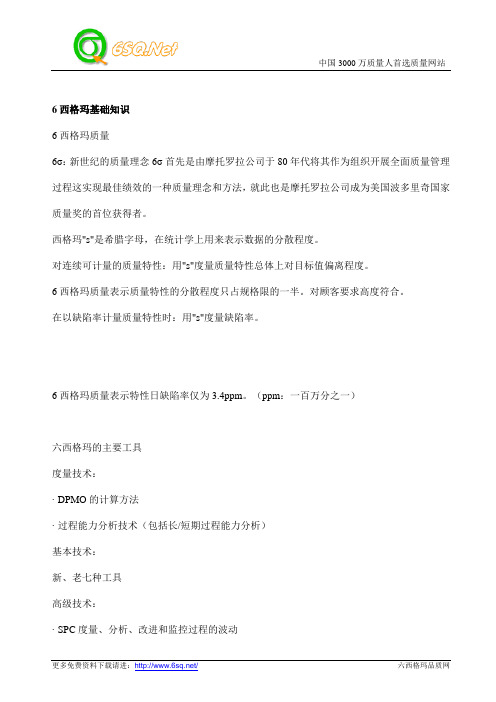
6西格玛基础知识6西格玛质量6σ:新世纪的质量理念6σ首先是由摩托罗拉公司于80年代将其作为组织开展全面质量管理过程这实现最佳绩效的一种质量理念和方法,就此也是摩托罗拉公司成为美国波多里奇国家质量奖的首位获得者。
西格玛"s"是希腊字母,在统计学上用来表示数据的分散程度。
对连续可计量的质量特性:用"s"度量质量特性总体上对目标值偏离程度。
6西格玛质量表示质量特性的分散程度只占规格限的一半。
对顾客要求高度符合。
在以缺陷率计量质量特性时:用"s"度量缺陷率。
6西格玛质量表示特性日缺陷率仅为3.4ppm。
(ppm:一百万分之一)六西格玛的主要工具度量技术:· DPMO的计算方法·过程能力分析技术(包括长/短期过程能力分析)基本技术:新、老七种工具高级技术:· SPC 度量、分析、改进和监控过程的波动· DOE/田口方法优化设计技术,通过DOE,改进过程设计,使过程能力达到最优· FMEA 风险分析技术,辅助确定改进项目,制定改进目标· QFD 顾客需求分析技术,辅助将顾客需求正确地转换为内部工作要求·防错从根本上防止错误发生的方法软技术:·领导力·提高团队工作效率·员工能力与授权·沟通与反馈六西格玛管理6西格玛管理是获得和保持企业在经营上的成功并将其经营业绩最大化的综合管理体系和发展战略。
是使企业获得快速增长的经营方式。
经营业绩的改善包括:·市场占有率的增加·顾客回头率的提高·成本降低·周期降低·缺陷率降低·产品/服务开发加快·企业文化改变是自上而下地由企业最高管理者领导并驱动的过程革新方法。
由最高管理层提出改进/革新的目标(这个目标与企业发展战略与远景密切相关)、资源和时间框架。
六西格玛标准

六西格玛标准六西格玛标准是一种以质量管理为核心的管理体系,它通过对流程的改善和优化,以及对缺陷和浪费的最小化,来实现组织的持续改进和高效运营。
六西格玛标准源自于20世纪80年代的美国,最初是由摩托罗拉公司引入的,后来被通用电气公司和其他许多跨国公司广泛应用。
六西格玛标准的核心理念是通过数据驱动的方法,不断地提高流程的稳定性和准确性,以达到最大程度的客户满意度和最小程度的浪费。
它强调的是对问题的深入分析和持续改进,以及对员工的培训和激励,以确保组织内部的每一个环节都能够达到最佳状态。
在六西格玛标准中,有一些核心的概念和工具,例如DMAIC(定义、测量、分析、改进、控制)模型、统计分析、质量功能部署(QFD)、故障模式和效应分析(FMEA)等。
这些工具和方法都旨在帮助组织发现问题、解决问题,并且预防问题的再次发生。
六西格玛标准的实施对于组织来说是一项全面的变革,它需要领导层的坚定支持和全员的参与。
首先,组织需要明确目标和方向,确定关键的业务指标和客户需求,然后通过数据的收集和分析,找出流程中的瓶颈和问题点,制定改进计划并且执行。
在这个过程中,员工需要接受相关的培训,学习使用六西格玛的工具和方法,以及改变他们的工作习惯和思维模式。
六西格玛标准的最终目标是使组织的流程变得更加稳定和可靠,产品和服务的质量得到提升,同时也能够在成本和时间上实现节约。
通过六西格玛的实施,组织可以更好地满足客户的需求,提高竞争力,实现持续的增长和盈利。
总的来说,六西格玛标准是一种以数据为基础的管理体系,它通过对流程的改善和优化,以及对缺陷和浪费的最小化,来实现组织的持续改进和高效运营。
它需要组织全员的参与和领导层的支持,以及对员工的培训和激励。
通过六西格玛的实施,组织可以提高质量、降低成本,从而实现持续的增长和盈利。
六西格玛等级划分标准

六西格玛是一种质量管理方法,旨在通过减少变异性和缺陷,提高产品和服务的质量水平 。在六西格玛中,通常使用一个等级划分标准来表示质量水平的高低。以下是常见的六西格 玛等级划分标准:
1. DPMO(每百万机会缺陷数): - 六西格玛:DPMO ≤ 3.4,表示每百万个机会中只有不超过3.4个缺陷发生。 - 五西格玛:3.4 < DPMO ≤ 6.7,表示每百万个机会中有3.4到6.7个缺陷发生。 - 四西格玛:6.7 < DPMO ≤ 13.6,表示每百万个机会中有6.7到13.6个缺陷发生。 - 依此类推,三西格玛、二西格玛、一西格玛等。
六西ห้องสมุดไป่ตู้玛等级划分标准
2. Sigma级别: - 六西格玛:Sigma级别为6,表示过程的性能水平非常高,几乎没有缺陷。 - 五西格玛:Sigma级别为5,表示过程的性能水平很高,缺陷数量很少。 - 四西格玛:Sigma级别为4,表示过程的性能水平较高,但仍有一定数量的缺陷。 - 依此类推,三西格玛、二西格玛、一西格玛等。
需要注意的是,六西格玛等级划分标准可以根据具体情况进行调整,不同组织和行业可能 会有不同的标准。此外,六西格玛的目标是使过程的性能接近理论上的极限,但并不代表绝 对的零缺陷。
六西格玛基础知识

六西格玛基础知识什么是六西格玛?六西格玛(Six Sigma)是一种管理方法论和质量管理体系,旨在通过减少缺陷和提高过程稳定性来提高业务绩效。
其名称来自于统计学中标准偏差(Standard Deviation)的符号“σ”。
六西格玛可以通过实施一系列工具和技术,从而能够使组织达到几乎没有缺陷的目标。
六西格玛的核心理念六西格玛的核心理念是基于数据驱动的决策和过程改进。
通过采集并分析数据,组织可以了解其过程的挑战和机会所在,并采取相应的改进措施。
六西格玛明确了以下三个关键概念:1.缺陷:运营过程中出现的不符合客户要求的情况,称为缺陷。
六西格玛的目标是减少缺陷,以提高产品和服务的质量。
2.DMC方法:DMC是六西格玛中的一种过程改进方法,它包括五个阶段:定义(Define)、衡量(Measure)、分析(Analyze)、改进(Improve)和控制(Control)。
通过按照DMC方法进行逐步改进,组织可以达到更高的质量水平。
3.关键业绩指标:六西格玛强调关键业绩指标(Key Performance Indicators,简称KPIs)的重要性。
通过衡量和追踪KPIs,组织能够评估其绩效并识别改进的机会。
六西格玛的优势六西格玛的应用可以带来许多优势,包括但不限于以下几个方面:1.提高质量:六西格玛通过减少缺陷,提高产品和服务的质量。
这有助于提高客户满意度并增加组织的竞争力。
2.提高效率:通过优化业务流程和消除浪费,六西格玛可以提高工作效率。
这有助于组织节约成本并提升生产力。
3.数据驱动决策:六西格玛强调基于数据的决策。
通过收集和分析数据,组织可以做出更明智的决策,降低决策风险。
4.全员参与:六西格玛鼓励全员参与过程改进。
通过培训和激励,组织能够激发员工的积极性和创造力,实现持续改进的目标。
六西格玛的应用六西格玛可以应用于各个行业和组织,无论是制造业、服务业还是公共部门。
以下是一些常见的六西格玛应用领域:1.生产流程改进:通过分析和改进生产流程,减少缺陷和浪费,提高生产效率和产品质量。
六西格玛基本知识
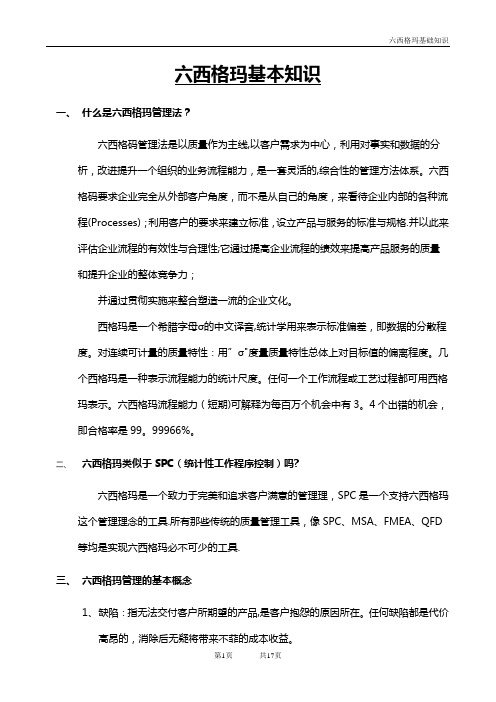
六西格玛基本知识一、什么是六西格玛管理法?六西格码管理法是以质量作为主线,以客户需求为中心,利用对事实和数据的分析,改进提升一个组织的业务流程能力,是一套灵活的,综合性的管理方法体系。
六西格码要求企业完全从外部客户角度,而不是从自己的角度,来看待企业内部的各种流程(Processes);利用客户的要求来建立标准,设立产品与服务的标准与规格.并以此来评估企业流程的有效性与合理性;它通过提高企业流程的绩效来提高产品服务的质量和提升企业的整体竞争力;并通过贯彻实施来整合塑造一流的企业文化。
西格玛是一个希腊字母σ的中文译音,统计学用来表示标准偏差,即数据的分散程度。
对连续可计量的质量特性:用”σ"度量质量特性总体上对目标值的偏离程度。
几个西格玛是一种表示流程能力的统计尺度。
任何一个工作流程或工艺过程都可用西格玛表示。
六西格玛流程能力(短期)可解释为每百万个机会中有3。
4个出错的机会,即合格率是99。
99966%。
二、六西格玛类似于SPC(统计性工作程序控制)吗?六西格玛是一个致力于完美和追求客户满意的管理理,SPC是一个支持六西格玛这个管理理念的工具.所有那些传统的质量管理工具,像SPC、MSA、FMEA、QFD 等均是实现六西格玛必不可少的工具.三、六西格玛管理的基本概念1、缺陷:指无法交付客户所期望的产品,是客户抱怨的原因所在。
任何缺陷都是代价高昂的,消除后无疑将带来不菲的成本收益。
2、缺陷机会:指产生不合格产品或不能满足客户要求的事件.3、偏差:指在过程或业务运作中,客户所能看见或感知的、可能发生的变化。
4、控制:指稳定、偏差正常并可预见的状态,是一个调整、指导运作以及使用定量数据的过程。
5、CTQ(关键性质量要素):指一次过程或者做法的要素,对于它可察觉的质量有直接的影响。
6、客户需求/期望:由客户定义的满足他们基本需求和标准的需求。
四、六西格玛质量步骤和程式DMAIC:即定义(define)、测量(measure)、分析(analysis)、改进(improve)、控制(control),指一个持续改进的过程.它是一种系统的、科学的、基于事实的过程.这种闭路过程消除了无效益步骤,经常注重于新的测量方式,并积极应用技术来追求改进。
六西格玛基本知识介绍

六西格玛基本知识介绍什么是六西格玛六西格玛(Six Sigma)是一种管理方法和业绩度量体系,用于改进企业的质量和效率。
它的目标是通过减小过程的变异性,将产品和服务的质量提高到几乎没有缺陷的水平。
六西格玛是由美国的摩托罗拉公司于1986年开发的,随后被通用电气公司引入,并逐渐在其他公司获得了广泛的应用。
六西格玛的原理六西格玛的核心思想是通过识别和解决问题的根本原因,来减少过程的变异性。
它采用了一套严格的工具和方法来帮助企业实现持续改进。
六西格玛的原理可以归纳为以下几个方面:1.客户导向:六西格玛强调以客户需求为中心,将产品或服务设计和交付过程与客户的期望相匹配。
2.数据驱动:六西格玛注重数据的分析和利用,通过收集和分析大量的数据来评估过程的性能,并识别引起问题的根本原因。
3.流程思维:六西格玛强调全局观念,将复杂的业务流程划分为若干个可管理的小步骤,以便更好地理解和优化整个过程。
4.持续改进:六西格玛是一个不断迭代的过程,它要求企业保持持续改进的态度,并通过定期的数据分析和评估来确保目标的实现。
六西格玛的核心指标六西格玛采用了一套统一的指标体系来衡量过程的性能和改进的效果。
以下是六西格玛的两个核心指标:1.DPU(Defects Per Unit):每单位产生的缺陷数。
DPU是六西格玛关注的一个关键指标,它用于衡量产品或服务的质量水平。
DPU越低,表示产品或服务的质量越好。
2.DPMO(Defects Per Million Opportunities):每百万个机会中的缺陷数。
DPMO是一个衡量过程能力的指标,用于评估过程的流程稳定性和能力。
DPMO越低,表示过程的稳定性和能力越高。
六西格玛的工具和方法六西格玛采用了多种工具和方法来帮助企业实现质量改进的目标。
以下是六西格玛的一些常用工具和方法:1.DMC(Define, Measure, Analyze, Improve, Control):这是六西格玛的一个基本工具,它是一个五个阶段的闭环过程,用于解决问题和改进过程。
6西格玛基础知识

6西格玛管理方法
六西格玛管理方法 ■六西格玛过程改进模式(DMAIC) D-define 界定阶段: M-measurement 测量阶段: A-analysis 分析阶段; I-improvement 改进阶段; C-control 控制阶段。
6西格玛管理方法
■各阶段的工作内容: D阶段:确认顾客的关键需求并识别需要改进的产 品或流程,决定要进行测量、分析、改进和控制的 关键质量特性,将改进项目界定在合理的范围内。 M阶段:通过对现有过程的测量和评估,制定期望 达到的目标及业绩衡量标准,识别影响过程输出Y 的输入Xs,并验证测量系统的有效性。
六西格玛管理对企业文化的影响
企业文化:简单地说,企业文化就是“我们这儿的 做事方式”。 当战略与文化发生冲突时,文化恒胜; 当企业文化与变革的精神不相容时,变革的努力将 遭到失败。 致力于产品与服务质量改进时,花大力气去改造与 六西格玛质量不相适应的企业文化。创造出良好的 企业文化,保证六西格玛质量战略的成功。
6西格玛质量
6西格玛质量
在平时描述时,使用6西 格玛,不用6σ,虽然有 些地方有混用。但6σ一 般就指六西格玛。 六西格玛兴起于摩托罗 拉公司,在通用电气, 杰克.韦尔奇手上得到发 扬光大。
六西格玛的主要工具
度量技术 ☆DPMO的计算方法: ◆单位缺陷数(DPU)=缺陷数/单位产品 数; ◆机会缺陷率(DPO)=缺陷数/产品数X 机会数; ◆百万机会缺陷率(DPMO)=DPOX106
6西格玛基础知识
品管部
内容简介
6西格玛质量 6西格玛的主要工具 6西格玛管理 6西格玛管理方法
6西格玛质量
6Sigma六西格玛常见问题解答
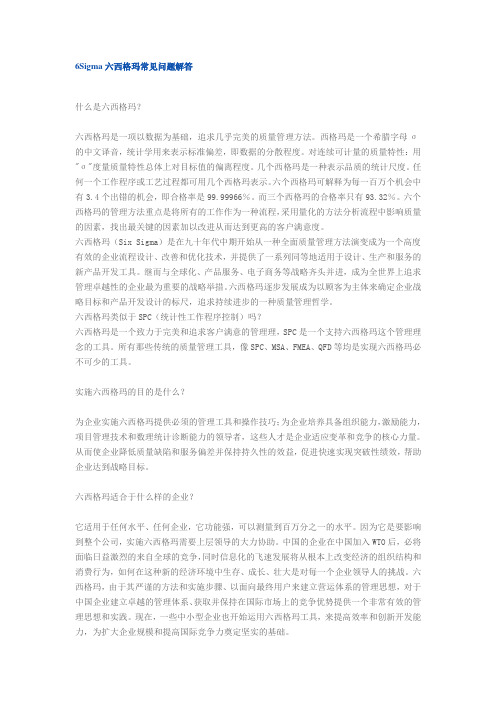
6Sigma六西格玛常见问题解答什么是六西格玛?六西格玛是一项以数据为基础,追求几乎完美的质量管理方法。
西格玛是一个希腊字母σ的中文译音,统计学用来表示标准偏差,即数据的分散程度。
对连续可计量的质量特性:用"σ"度量质量特性总体上对目标值的偏离程度。
几个西格玛是一种表示品质的统计尺度。
任何一个工作程序或工艺过程都可用几个西格玛表示。
六个西格玛可解释为每一百万个机会中有3.4个出错的机会,即合格率是99.99966%。
而三个西格玛的合格率只有93.32%。
六个西格玛的管理方法重点是将所有的工作作为一种流程,采用量化的方法分析流程中影响质量的因素,找出最关键的因素加以改进从而达到更高的客户满意度。
六西格玛(Six Sigma)是在九十年代中期开始从一种全面质量管理方法演变成为一个高度有效的企业流程设计、改善和优化技术,并提供了一系列同等地适用于设计、生产和服务的新产品开发工具。
继而与全球化、产品服务、电子商务等战略齐头并进,成为全世界上追求管理卓越性的企业最为重要的战略举措。
六西格玛逐步发展成为以顾客为主体来确定企业战略目标和产品开发设计的标尺,追求持续进步的一种质量管理哲学。
六西格玛类似于SPC(统计性工作程序控制)吗?六西格玛是一个致力于完美和追求客户满意的管理理,SPC是一个支持六西格玛这个管理理念的工具。
所有那些传统的质量管理工具,像SPC、MSA、FMEA、QFD等均是实现六西格玛必不可少的工具。
实施六西格玛的目的是什么?为企业实施六西格玛提供必须的管理工具和操作技巧;为企业培养具备组织能力,激励能力,项目管理技术和数理统计诊断能力的领导者,这些人才是企业适应变革和竞争的核心力量。
从而使企业降低质量缺陷和服务偏差并保持持久性的效益,促进快速实现突破性绩效,帮助企业达到战略目标。
六西格玛适合于什么样的企业?它适用于任何水平、任何企业,它功能强,可以测量到百万分之一的水平。
- 1、下载文档前请自行甄别文档内容的完整性,平台不提供额外的编辑、内容补充、找答案等附加服务。
- 2、"仅部分预览"的文档,不可在线预览部分如存在完整性等问题,可反馈申请退款(可完整预览的文档不适用该条件!)。
- 3、如文档侵犯您的权益,请联系客服反馈,我们会尽快为您处理(人工客服工作时间:9:00-18:30)。
27
对用户来讲什么是重要的? 我们怎么知道?
28
什么是用户?
用户是产品和/或服务的接受者
用户
外部用户
产品/服务
内部用户
产品/服务
29
练习
假设你是一位非常成功的连锁经营影剧院的总 经理,拥有许多雇员。你将出国三个月,并要求雇 员每星期一早晨将周报传真给你。你希望在周报上 看到什么?
好莱坞公司周报
General Electric成功实施6
从1995年开始使用 6-Sigma 已经有5000多名黑 带工程师
5
6的背景-效果
GE 1996-2000ÄÄÄ6-SigmaÄÄÄÄ ê Ä §
20
15
10
5
0
1996
1997
1998
1999
2000
6
6背景-应用领域
SERVICE 服务 DESIGN 设计
6σ概论
1
内容
简要回顾
推进战略
工具-DMAIC
了解6
2
6s的背景-出现
6s从哪里开始? 1982年摩托罗拉公司实施质量改善计划。
质量改善工作表明需要改进分析工具。 研究出6s工具。 1988年摩托罗拉公司赢得美国国家质量奖。
3
6的背景-实施的公司
哪些公司在实施6?
46Leabharlann 背景-GE成功实施6• 一再出现的一组活动 • 有“ 一 个结果”(输出 )
D-M-A-I-C方法与过程有关
21
过程图
过 程 混合输入 以实现 某些输出
输出
输入
材料 控制 机器 等…
作为衡量 过程成功 指标的量
成功:由顾客判断---顾客声音 输出:由过程决定---过程声音 衡量尺度: 通过你测量的东西来进行观察
22
测量→评价→行动
13
中大奖的机会
MONTY HALL给你看台上的3个箱子,告诉你有一个箱子下面是一辆
新车,有个箱子下面是山羊。他请你选择一个箱子,你选择后,他告
诉你在剩下的两个箱子中,有一个箱子下是山羊。他问你是否愿意改 变选择。你愿意吗?有关系吗?如果你改变选择,会增加赢得汽车的
机会吗?
14
直觉将我们引入岐途时,数据能帮我们正确 判断
变差太大
X X
X
X X X
X X
X
击中目标
X
集中过程
XXXXX X XXX X X XX X
减少分散
6方法鉴别偏离目标过程和(或)变
动较大的过程,并对过程进行修正。
48
战略
了解对顾客最重要的是什么
减少缺陷
集中到目标上
减少变动
突破改善,不是增量改善 !
49
6 的目标
缺陷减少
盈利增加
提高用户满意度
测量方法错误会导致错误的行为
例: – “服务器停机时间” 与 “PC 停机时间”: 衡量 “服务器停机时间” 无法说明 PC 硬 件的问题,硬件问题使系统无法运行,并且 看上去似乎是服务器的问题。
23
100000 10000 1000 100 10 1
1993 1994 1994 1994 1994 1995 1996 1997
知识质量
11
成本
改善的可能性
理解深度
收集数据、数据的重要性
数据形成知识
数据 这种共同语言的重要性
以客观 方式交流 收集有关问题或机会的可量化事实 建立有关问题或过程的基本信息 便于对提出的方案进行成本效益分析
前 、后 比较-对方案的影响进行量化
证明 方案
12
用数据向导做决策
我们只能根据掌握的情况采取行动 我们研究探索后才能掌握更多情况。 我们对提出的问题进行研究和探索。 我们对事物测量之后才能提出问题。 如果我们提出了问题并进行测量,那么决策就 是以数据资料为基础,而不是凭直觉。
增加股东收益
50
6 - -目标
PPM
工序能力
2 3 4 5 6
308,537 66,807 6,210 233 3.4
每百万个 机会中的缺陷数
(DPMO 分布 移 动±1.5)
51
当前工业立足于何处?
(在±1.5σ内变化)
PPM
1,000,000 100,000 10,000 1,000 100
©1994 6σ Academy
52
6-- 实际意义
99% 好 (3.8 )
• 每小时丢失20,000个邮件 • 每天有几乎15分钟人们在饮用对人 体有害的水 • 每周有5,000次外科手术有误 • 在主要机场每天有2架飞机提前或 延迟降落 • 每年开错20万张处方 • 每月几乎有7小时停电
99.99966% 好 (6 )
(切实的、可见的)
重新认证成本 过长的生产周期 赶工成本
丧失销售机会 延迟交货
隐蔽的低质量成本
(无形的、隐藏的)
隐含的损失
诉讼费用 紧急定单 库存 保证成本 用户忠诚度降低 过度的维修成本
小额费用
25
传统观点的绩效
“99%好”的实际含义: 每小时丢失20,000个邮件 每天有至少15分钟人们饮用不健康饮水 每星期有5,000次外科手术错误 在主要机场每天有2架飞机班次延误 每年开错20万张处方
当提到某项是CTQ时 ,我们能从顾客的角度说明它吗?
能从我们的角度说明它吗?
我们能论证二者的关系吗?
33
用户最介意什么问题?
产品 质量 服务 质量
• 可靠性 • 耐久性 • 可用性/特色
• 知名度 • 实用性 • 可维修性能
• 方便程度 • 可靠程度 • 响应速度
• 待遇和交流 • 真实程度 • 维修
6-Sigma项目 工作重点
19
6工作的核心
期望
用户感觉
CTS(atisfaction) 结果
用户
厂商
输入
过程
输出 CTQ(uality) CTC(ost) CTD(elivery)
20
因素 CTP(rocess)
CT = Critical To …
6工作的核心-过程
必须从一个过程开始
什么是过程?
6指绩效水平,这种绩效水平反映大
幅度降低产品和服务中的缺陷数
6是工序能力的统计衡量,以及用于
同业的比较
6是一组统计“工具”,帮助我们
测量、分析、改善及控制 过 程 (MAIC)
拓宽我们考虑质量和业务问题的思路
16
6 组 合
设定目标 过程 有效的工具
17
6s 总图
6s = 3.4 DPMO 6s -目标 ss
Q1
Q2
Q3
Q4
每100万机会的过程缺陷
我们不会知道我们不知道的事情。 如果不能用数字来表达我们所知,说明我们知之甚少。
如果我们知之甚少, 就无法控制它。
如果我们不能控制它, 就不能把握机会。 24
低质量成本 - 冰山
明显的损失
产能损失 索赔 返工 降低产品等级
传统的低质量成本看法
2 3 4 5 6 308,537 66,807 6,210 233 3.4
PPM PPM
能力 通过瞄准正确目标
通过缩小分布实现
每百万 机会缺陷数
工序 Process 能力 Capability
18
6项目确定标准
是否是重复事件? 范围是否可以逐步缩小? 能否进行确定的度量? 过程是否能够受控? 是否能改变用户满意度
合格率
1_01_01_015
风险
缺陷率
= 100%
+
= 100%
37
如何衡量变差
38
问题的本质-从统计学角度看
另一种角度
偏离目标 变差太大
LSL
USL
LSL
USL
达到目的
集中过程
LSL USL
减少分散
LSL = 规定下限
从统计角度看问题
USL = 规定上限 39
工序能力和表现
40
能力 = VOC / VOP
. . . 为什么在观点上存在这么多的差异?
32
用户使用不同的语言
顾客说:
长寿命 可靠 功能强大的计算机….
公司说:
20,000小时的寿命 3000小时的平均故障间隔时间 2000MHz…
顾客能告诉和不能告诉你的 • 顾客知道自己想要什么! • 顾客能告诉你需求,不能告诉你准确的特性和解决方案 • 顾客不是工程师,通常不会设臵技术要求 • 听取顾客的意见意味着了解需求
ADMIN 管理
PRUCH。 采购
6
Methods
6方法
QA 质保 MAINT. 维修 MFG.. 制造
Marketing 市场
只 要 有 过 程 存 在, 无 论 是 制 造 产 品, 收 集 数 据, 还 是 写 发 票, 都 可 以 应 用 6s方 法.
7
6描述
用户推动的6工程
是一种用于提高用户满意度,同时通过减少 商业活动中的各个方面的变差提高股东收 益的工具。
修改后的设计宽度(2*VOC)
标准偏差
什么是 ?
m
拐 点
拐点与均值的距离是一个标准偏差。 若目标值与规定界限间有3个标准偏 差,我们就说 过 程具有“3s 能力”
1
T
缺 陷
规格上限 (USL) 目标值 (T) 规格下限 (LSL) 分布的均值 (m) 分布的标准偏差(s)
USL
3
44
能力 = VOC / VOP
每个月几乎有7小时停电
长期的合格率
3 能力 4 能力 6 能力
